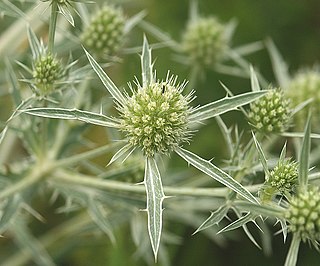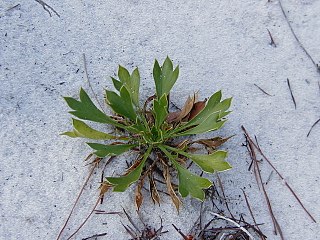
Eryngium is a genus of flowering plants in the family Apiaceae. There are about 250 species. The genus has a cosmopolitan distribution, with the center of diversity in South America. Common names include eryngo and sea holly.

Maianthemum racemosum, the treacleberry, feathery false lily of the valley, false Solomon's seal, Solomon's plume or false spikenard, is a species of flowering plant native to North America. It is a common, widespread plant with numerous common names and synonyms, known from every US state except Hawaii, and from every Canadian province and territory, as well as from Mexico.

Eryngium yuccifolium, known as rattlesnake master, button eryngo, and button snake-root, is a perennial herb of the parsley family native to the tallgrass prairies of central and eastern North America. It grows from Minnesota east to Ohio and south to Texas and Florida, including a few spots in Connecticut, New Jersey, Maryland, and Delaware.

Eryngium campestre, known as field eryngo, or Watling Street thistle, is a species of Eryngium, which is used medicinally. A member of the family Apiaceae, eryngo is a hairless, thorny perennial plant. The leaves are tough and stiff, whitish-green. The basal leaves are long-stalked, pinnate and spiny. The leaves of this plant are mined by the gall fly, Euleia heraclei.
Great Valley Grasslands State Park is a state park of California, United States, preserving a parcel of remnant native grassland in the San Joaquin Valley. Such a temperate grasslands, savannas, and shrublands biome was once widespread throughout the whole Central Valley. The 2,826-acre (1,144 ha) park was established in 1982. Largely undeveloped, it was formed by combining two former state park units: San Luis Island and Fremont Ford State Recreation Area. Its chief attractions for visitors are spring wildflowers, fishing, and wildlife watching.

Eryngium aristulatum, known by the common names California eryngo and Jepson's button celery, is a species of flowering plant in the family Apiaceae.

Eryngium armatum, known by the common names coastal eryngo and prickly coyote thistle, is a species of flowering plant in the family Apiaceae.
Eryngium castrense is a species of flowering plant in the family Apiaceae known by the common name Great Valley eryngo, or Great Valley button celery. This plant is endemic to California, where it grows in wet areas such as vernal pools and ponds in the central part of the state. This is a heavily branched, spiny perennial herb reaching maximum heights of around half a meter. It produces light green to grayish green hairless stems with occasional lobed, oval-shaped leaves. At the tops of the stems are flower heads one to one and a half centimeters wide and rounded or egg-shaped. At the base of each head is an array of 7 to 9 spiny, pointed bracts up to three centimeters long, and sometimes a few smaller bractlets above. The rounded flower head contains many small white to light purple flowers.
Eryngium constancei is a species of flowering plant in the family Apiaceae known by the common name Loch Lomond button celery, or Loch Lomond coyote thistle. It is endemic to California, where it is known from only three occurrences north of the San Francisco Bay Area. One of the populations is at the Loch Lomond Vernal Pool Ecological Reserve at Loch Lomond in Lake County. The plant appears mainly in vernal pools. It is endangered on the state and federal levels.

The Loch Lomond Vernal Pool Ecological Reserve is a nature reserve of 8.22 acres (33,300 m2) in the community of Loch Lomond in Lake County, California. It is one of 119 ecological reserves managed by the California Department of Fish and Game (CDFG). The ecological reserve system was authorized by the state legislature in 1968 for the purpose of conservation and protection of rare plants, animals and habitats.

Cirsium hydrophilum is a species of thistle which is endemic to California, where it is found only in the San Francisco Bay Area and the Sacramento-San Joaquin River Delta. This native thistle grows in wet boggy habitats.
Eryngium mathiasiae is a species of flowering plant in the family Apiaceae known by the common name Mathias' eryngo, or Mathias' button celery.
Eryngium pinnatisectum is an uncommon species of flowering plant in the family Apiaceae, known by the common names Tuolumne eryngo and Tuolumne button celery.
Eryngium spinosepalum, known by the common names spinysepal eryngo and spiny-sepaled button celery, is an uncommon species of flowering plant in the family Apiaceae.

Eryngium pendletonense is a rare species of flowering plant in the carrot family known by the common name Pendleton button-celery. It is endemic to northern San Diego County, California, where it is known from four occurrences along the coastline between Oceanside and the Orange County border, including land within Camp Pendleton. It grows on vernally moist coastal grassland and coastal sage scrub habitat with clay soils. It was first described as a species in 1999.

Cirsium vinaceum is a rare species of thistle known by the common name Sacramento Mountains thistle. It is endemic to Otero County, New Mexico, in the United States, where it is known only from the Sacramento Mountains. The plant can be found in six canyon systems in a southern section of this mountain range spanning about 32 kilometers. It is rare because it is limited to a specific type of mountain wetland which is both naturally uncommon and threatened by a number of forces. The plant was federally listed as threatened in 1987.

Deinandra conjugens is a rare species of flowering plant in the family Asteraceae known by the common names Otay tarplant and Otay tarweed. It is native to a small section of far northern Baja California in Mexico, its range extending north into San Diego County, California, in the United States. One isolated population has been reported from the hills east of Cayucos in San Luis Obispo County.

Eryngium cuneifolium is a rare species of flowering plant in the carrot family known by the common names wedgeleaf eryngo, wedge-leaved button-snakeroot, and simply snakeroot. It is endemic to the state of Florida in the United States where it is known only from Highlands County. It is one of many rare species that can be found only on the Lake Wales Ridge, an area of high endemism. It was federally listed as an endangered species of the United States in 1987.

Pityopsis ruthii is a rare species of flowering plant in the family Asteraceae known by the common name Ruth's golden aster. It is endemic to the US state of Tennessee, where it is known only from Polk County. It is threatened by the modification of its habitat. It is a federally listed endangered species.

Eryngium aquaticum is a species of flowering plant in the family Apiaceae known by the common name rattlesnakemaster, marsh rattlesnake master, corn-snakeroot, bitter snakeroot, and marsh eryngo. This plant is native to eastern North America.














